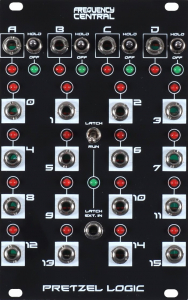Description
Dusseldorf Academy multi-row analogue sequencer is based around the classic CD4017 Johnson counter chip, under the control of a 16F1765 PIC which provides many novel features:
4 programmable rows
CV A output is quantised in chromatic steps from 0V to 5V.
CV B output is unquantised, 0V to 5V.
Gate A, 0V off and 5V on.
Gate B, 0V off and 5V on.
Quantised Transpose
CV A output may be transposed both manually using the Transpose knob, and externally using the Transpose CV Input. In both cases transpositions are quantised chromatically. You can use an external 1V/oct keyboard, or another sequencer to transpose Dusseldorf Academy.
Series/Parallel operation:
Series AB:
- CV A output steps through Row A CV, followed by Row B CV, quantised chromatically.
- CV B outputs Row B unquantized.
- Gate A outputs Row A gates, followed by Row B gates.
- Gate B outputs Row B gates.
Parallel A/B:
- CV A output steps through Row A, quantised chromatically.
- CV B output steps through Row B, unquantized.
- Gate A outputs Row A gates.
- Gate B outputs Row B gates.
Series AABB:
- CV A output steps through Row A CV twice, followed by Row B CV twice, quantised chromatically.
- CV B outputs Row B unquantized.
- Gate A outputs Row A gates twice, followed by Row B gates twice.
- Gate B outputs Row B gates.
Edit Mode
The edit mode is designed for programming CVs with sequencer stopped.
- Stop the sequencer at it’s clock source.
- Flip Mode A switch to it’s middle position
- Press Step, the current step’s CV value will be outputted.
- Move the current step’s knob and press Step again, you’ll hear the new CV value.
- Repeat until the desired value is reached.
To work on the next step’s CV value:
- Flip Mode A switch to Single.
- Press Step to advance to the next step.
- Flip Mode A switch to it’s middle position
- Press Step, the current step’s CV value will be outputted.
- Move the current step’s knob and press Step again, you’ll hear the new CV value.
Gate On/Off/Tied per step
Each step may be either On (short pulse), Off, or Tied to the next step
Individual gate outputs per step
Gate outputs for steps 1 through to 8. 0V low, 5V high. You can use these to trigger external envelopes etc, or patch one back to the Reset input to get sequence lengths not offered by the 4/8/6 step switch.
Onboard clock divisions
Dusseldorf Academy will take the incoming clock and divide it, so each step will linger longer. The following are available: /1, /2, /3, /4, /5, /6, /7, /8. Additionally…..
External voltage control of clock division
0V to 5V. For example, the user may use Row B to define the individual step lengths of Row A. As the Division CV input is quantised, the steps will always be rhythmically accurate.
Single or Multiple gates per row
This applies when Division is set to /2 to /8. It has no affect when Division is set to /1.
- Single means that only one gate per step will be generated.
- Multiple means that the number of gates per step will correspond to the Division
For example, with Division set to 4, Dusseldorf Academy will take one step forward for every 4 clock pulses received. In Single mode, one gate will be generated for every 4 clock pulses received. In Multiple mode step 1 will produce 4 gates before advancing to step 2, and so on.
4 step / 6 step / 8 step options
For quick manual variations. Other step lengths may be set up by patching one of the individual gate outputs



